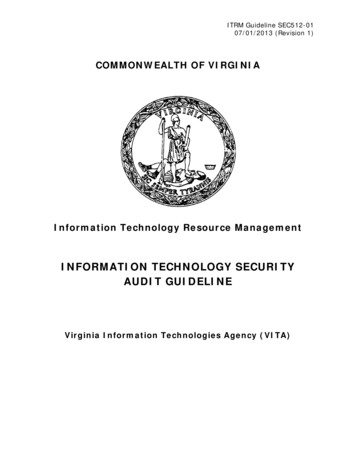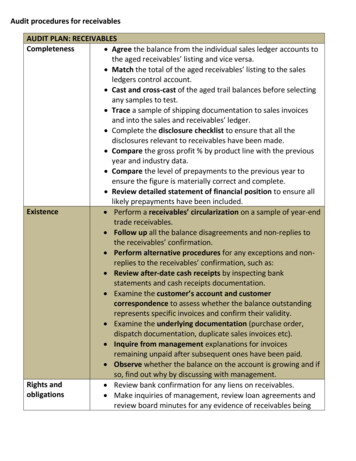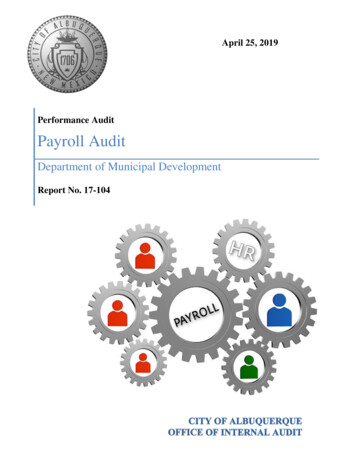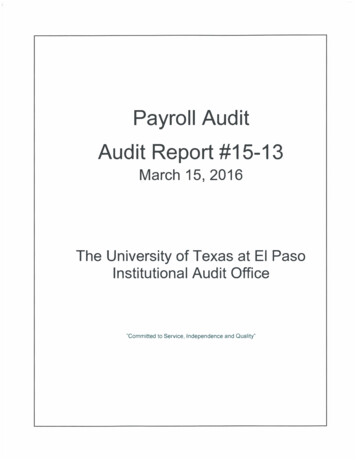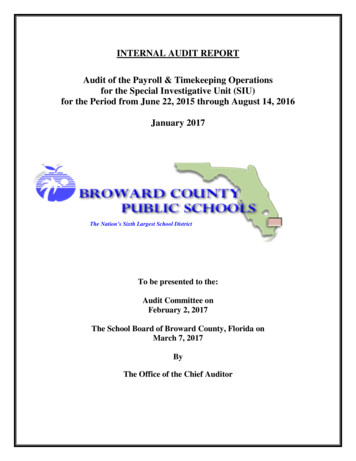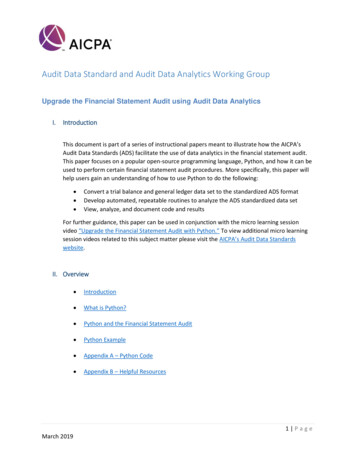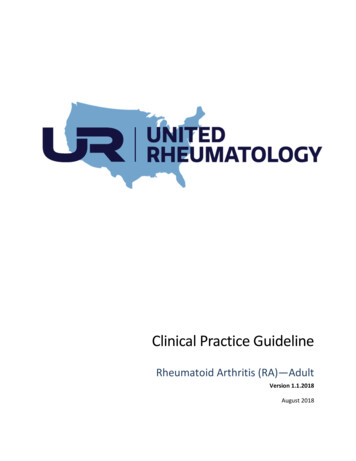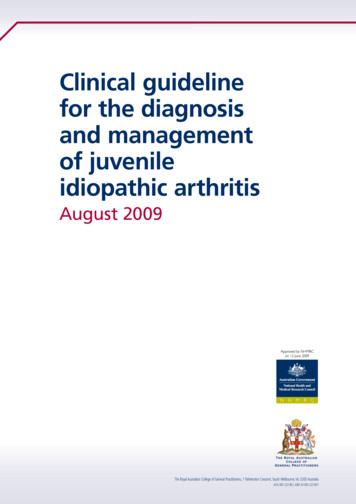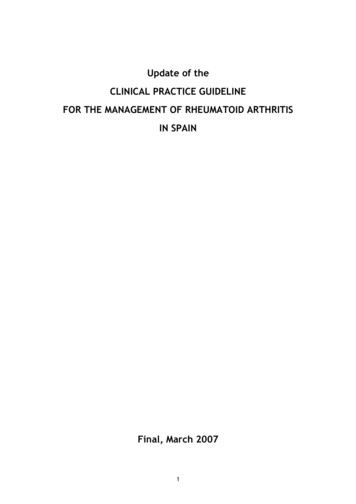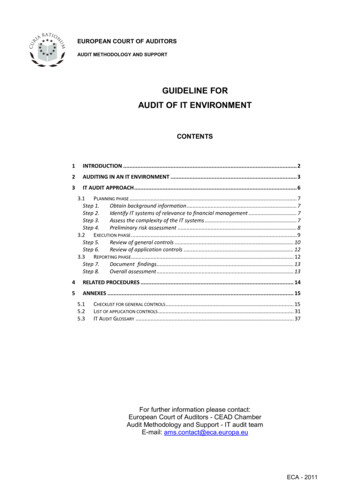
Transcription
EUROPEAN COURT OF AUDITORSAUDIT METHODOLOGY AND SUPPORTGUIDELINE FORAUDIT OF IT ENVIRONMENTCONTENTS1INTRODUCTION . 22AUDITING IN AN IT ENVIRONMENT . 33IT AUDIT APPROACH . 63.1 PLANNING PHASE . 7Step 1.Obtain background information . 7Step 2.Identify IT systems of relevance to financial management . 7Step 3.Assess the complexity of the IT systems . 7Step 4.Preliminary risk assessment . 83.2 EXECUTION PHASE . 9Step 5.Review of general controls . 10Step 6.Review of application controls . 123.3 REPORTING PHASE. 12Step 7.Document findings. 13Step 8.Overall assessment . 134RELATED PROCEDURES . 145ANNEXES . 155.15.25.3CHECKLIST FOR GENERAL CONTROLS . 15LIST OF APPLICATION CONTROLS . 31IT AUDIT GLOSSARY . 37For further information please contact:European Court of Auditors - CEAD ChamberAudit Methodology and Support - IT audit teamE-mail: ams.contact@eca.europa.euECA - 2011
1InformationtechnologyINTRODUCTION1. The resources used in information technology (IT) are infrastructure,applications, information and people. An IT system designed for use infinancial and management reporting will have procedures and databases forinitiating, recording, processing and reporting transactions (as well asevents and conditions) and maintaining accountability for the correspondingassets, liabilities and equity.2. Increasingly, the use of IT systems is having an impact on audit. Therisks associated with IT must be taken into account when evaluating thereliability of accounts, the legality and regularity of underlying transactionsand the effectiveness of internal control systems.Scope of thisguideline3. The methodology for auditing in an IT environment varies according towhether the objective is a financial, performance or IT audit. For illustrativepurposes, this guideline focuses on the task of financial audit in an ITenvironment in accordance with the Court's Audit Policies and Standards(CAPS).4. Section 2 of the guideline presents the risks introduced by computerisedinformation systems and the interconnections between financial audit andthe IT environment.5. Section 3 provides step-by-step guidance for IT audit work in the contextof financial audit. It defines eight steps, broken down into planning,execution and reporting phases.6. Lastly, Section 4 addresses the related procedures arising in the overallcontext of the Court’s audit work.7. The guideline concludes with annexes: a "Checklist for generalcontrols" and a "List of application controls" to help auditors perform ITaudit tasks, and an “IT audit glossary”.ECA – 2011Guideline for Audit of ITp2
2IT risks and controlsin the internalcontrol frameworkAUDITING IN AN IT ENVIRONMENT8. Most financial transactions and statements are now processed orproduced using IT systems. The procedures for initiating, recording,processing and reporting transactions and recording the correspondingassets and liabilities are usually implemented within IT systems. Given,therefore, that financial data are now predominantly electronic data, financialand administrative controls are also increasingly electronic in nature.9. The storage and processing of information in IT systems introduces newrisks and possible control weaknesses, owing mostly to the ease with whichdata and the IT systems themselves can be modified.10. IT systems are one of the five components of the internal controlframework (ISA 315 1, paragraphs A81-A87), and key IT controls should bein place to mitigate the IT-related risks and thus ensure the confidentiality,availability and integrity of data and the efficiency and effectiveness ofbusiness processes. The following table gives examples of risks and their ITsources:RiskIT-related risk sourceIndividual errors becomesystematicAutomation replacing manualoperationsFailure to identify the performer ofthe transactionElectronic transactions not loggedUnauthorised access andchanges to dataElectronic data not properlysecuredLoss (destruction) of dataElectronic data not protected(backups and archiving)Disclosure of confidentialinformationElectronic data not properlysecuredControl weaknesses undetected.IT risks and controls not(adequately) considered in auditTable 1: Risks with an IT nloads/a017-2010-iaasb-handbook-isa-315.pdfECA – 2011Guideline for Audit of ITp3
11. The use of IT systems in business processes changes the nature ofaudit evidence, the audit trail and the internal control environment. It alsocreates new vulnerabilities to irregularities and fraud, and new auditprocedures are therefore necessary in order to deal with these challenges.12. Where accounting or other information systems are computerised, theauditor determines whether internal controls are functioning properly toensure the integrity, reliability and completeness of the data (INTOSAIAuditing Standards ISSAI 300 2, 3.4).Audit objectives13. The audit of controls on IT systems should have specific objectives,including verification of the accounts or other data produced by the system(e.g. data extracted for sampling purposes). The evaluation of internalcontrols should vary according to the type of audit and the degree ofreliance the auditor wishes to place on them (INTOSAI Auditing StandardsISSAI 300, 3.2).Reliability of data14. When IT systems data are an important part of the audit and datareliability is crucial to accomplishing the audit objective, auditors need tosatisfy themselves that the data are reliable and relevant (INTOSAI AuditingStandards ISSAI 300, 5.2).15. Data produced, stored or provided to the auditor by means of IT shouldnot be treated as reliable until the auditor has convincing evidence that thisis so. The components of reliability are accuracy, completeness andvalidity. The quality of the data received from the auditee may significantlyinfluence whether or not the audit objectives are achieved.16. Evidence for the reliability of the computerised data provided by anauditee may come, depending on the nature of the data, from assurancethat internal controls on IT are functioning securely and correctly, fromcross-checking of the data (e.g. by reconciling them with data from othersources), or from a combination of the two.17. The absence of appropriate IT controls may give rise to conditions andevents indicating a risk of material misstatement. This in turn wouldinfluence the nature, timing and extent of subsequent IT-related 33)/ISSAI 300 E.pdfECA – 2011Guideline for Audit of ITp4
Use of IT audit infinancial audit18. The objectives of IT audit in the context of a financial audit include:a) Understanding the overall impact of IT on key business processes;b) Assessing management controls on IT processes;c) Understanding how the use of IT for processing, storing andcommunicating information affects internal control systems, inherentrisk and control risk;d) Evaluating the effectiveness of controls on IT processes whichaffect the processing of information.Use of IT audit inperformance audit19. IT audit may be used in the context of a performance audit when:a) The audit focuses on the performance of IT systems;b) The audit examines the efficiency and effectiveness of a businessprocess and/or programme where IT is a critical tool for theorganisation managing these processes or programmes;c) Data reliability is to be assessed.Typical IT auditwork in the Court20. IT audit work in the Court occurs mainly in the context of:a) Financial audits: reviewing key general controls and relatedapplication controls on information systems;b) Compliance audits: reviewing whether IT controls comply with rulesand regulations, usually the Financial Regulation 3 (FR) and InternalControl Standards 4 (ICS);c) Specific IT audits: when the main audit objective is linked to theeffectiveness and efficiency of .do?uri CONSLEG:2002R1605:20071227:EN:PDF4 s/control/sec 2007 1341 annexes en.pdfECA – 2011Guideline for Audit of ITp5
3IT audit tasksIT AUDIT APPROACH21. The following IT audit tasks are necessary so that audits can be plannedand implemented fully in accordance with the CAPS.22. IT audit work consists of the following steps:PLANNING1. Obtain background information2. Identify IT systems of relevance tofinancial management3. Assess complexity of IT systemsChecklist forgeneral controls4. Preliminary risk assessmentEXECUTION5. Review of general controlsRefined checklistforgeneral controlsAre general controls effective?NOYES6. Review of application controlsList ofapplicationcontrolsREPORTING7. Document findings8. Overall assessmentECA – 2011Guideline for Audit of ITp6
3.1 Planning phase23. The objective of the planning phase is to identify risks that are relevantto the audit goals and determine which controls will be assessed during theexecution phase:a) General controls (as for the IT control environment);b) Application controls (in IT applications of relevance to financialmanagement).Step 1. Obtainbackgroundinformation24. During the planning phase it is important for the auditor to obtain anunderstanding of the auditee's IT systems, an inventory of the auditee’s ITsystems and resources (IT budget and staffing, IT organisation, softwareand hardware) and a statement of the concerns arising from previousinternal or external audits of IT systems.Step 2. IdentifyIT systems ofrelevance tofinancialmanagement25. IT systems for accounting and financial reporting comprise proceduresand databases for initiating, recording, processing and reportingtransactions and recording the auditee's corresponding assets and liabilities.26. The auditor must identify which IT applications are important in thecontext of financial reporting and business management and obtainsufficient information and understanding in their regard.27. In order to facilitate the evaluation of risks and the planning of IT audittasks, the auditor should document:a) which IT applications feed into the financial statements;b) which transactions are processed through these IT applications;c) which areas of accounts (such as administrative expenditure) arecovered by these IT applications.Step 3. Assessthecomplexity ofthe ITsystems28. The purpose of assessing the complexity of IT systems is to:a) Identify risks - complex systems are more risky than simple ones;b) Decide whether there is a need for external assistance. In principle,auditors are competent to carry out IT audit tasks in relation tosimple systems, with the IT audit team providing support in the auditof more complex systems.ECA – 2011Guideline for Audit of ITp7
29. The following factors will influence this assessment:a)b)c)d)Hardware and network complexity;IT applications and data entry methods;IT organisation;The presence of systems under development or recently subject tochange;e) The sensitivity of the processed data;f) Any specific difficulties affecting the audit trail;g) The auditor’s technical knowledge and skills.Step 4. Preliminaryrisk assessment30. Using all the information obtained in the previous steps, the auditor willthen make a preliminary risk assessment.31. Just as in the more general audit context, internal control in ITcomprises two elements:a) the internal control environment, i.e. the overall attitude,awareness and actions of management;b) internal control procedures, i.e. procedures complementary to thecontrol environment which contribute to the entity’s achievement ofits objectives.32. Please note that the overall assessment of control risk should notbe better to the assessment of the internal control environment, sinceeven excellent control procedures can be undermined by a poor controlenvironment.Identifying the riskof materialmisstatement33. The auditor should be aware of conditions or events that may indicate arisk of material misstatement consequent upon the use of IT (ISA 315,paragraphs A33 and A115 and Appendix 2). The following is anon-exhaustive list of factors that should be considered, when performingthe preliminary risk assessment, as contributing to the risk of materialmisstatement:a) Changes in the IT environment;b) Installation of significant new IT systems;c) Insufficient controls on the transfer of data between IT systems;d) Inconsistency
When IT systems data are an important part of the audit and data reliability is crucial to accomplishing the audit objective, auditors need to satisfy themselves that the data are reliable and relevant (INTOSAI Auditing Standards ISSAI 300, 5.2). 15. Data produced, stored or provided to
